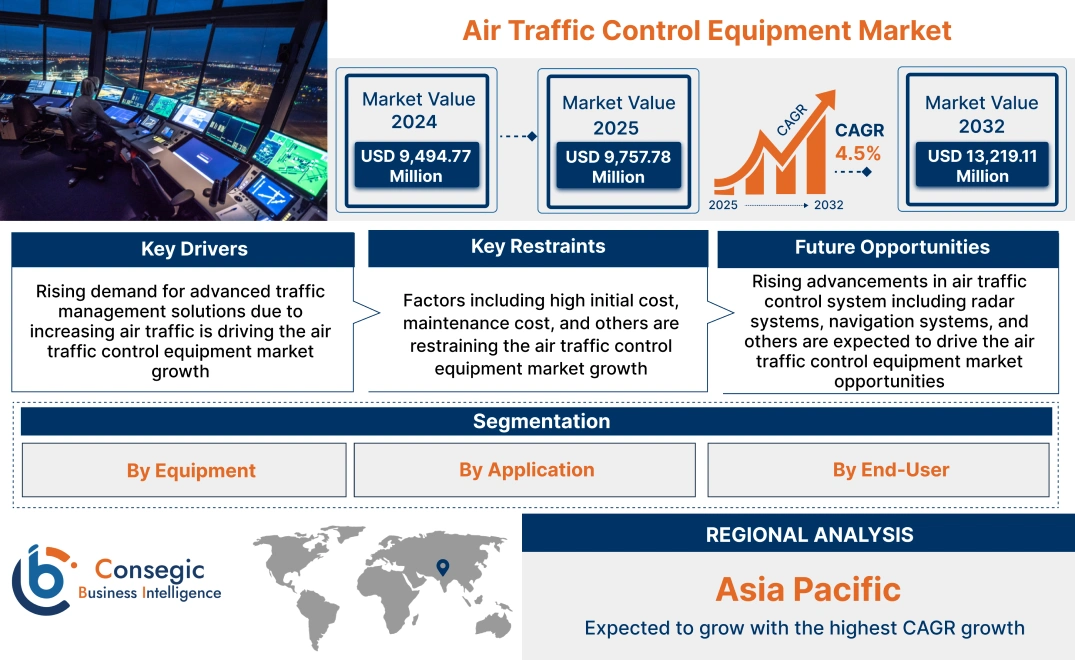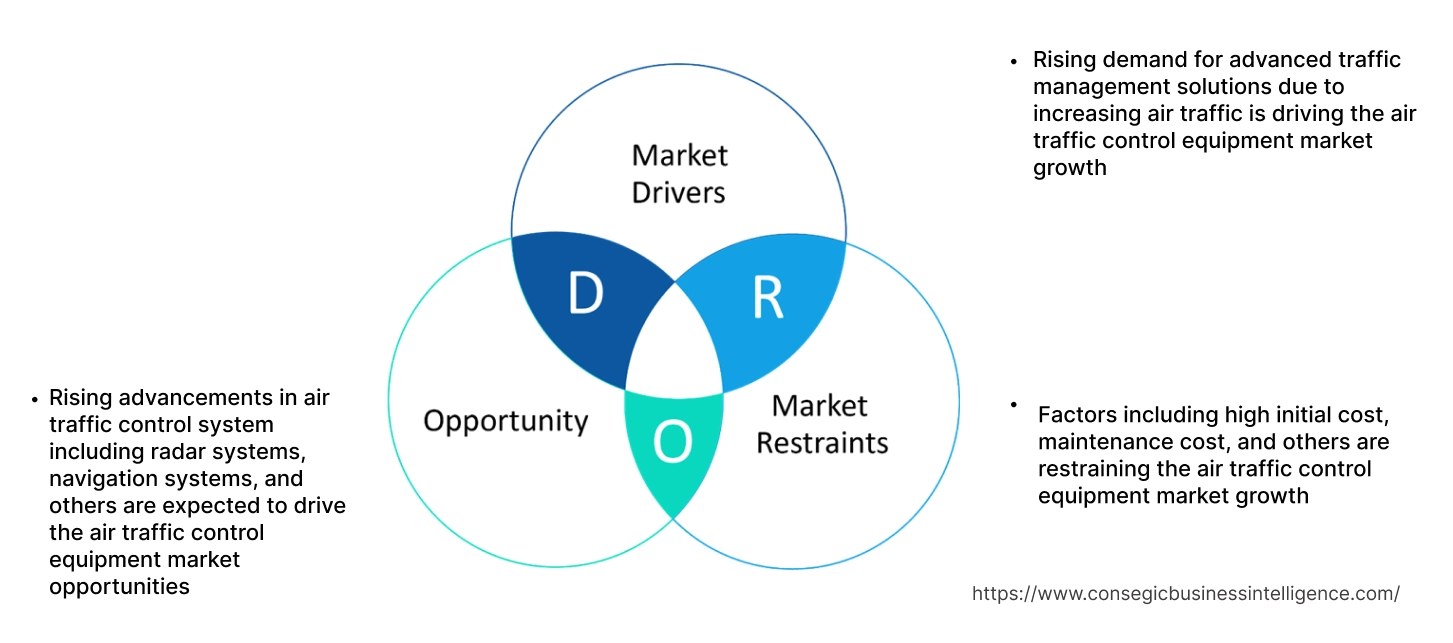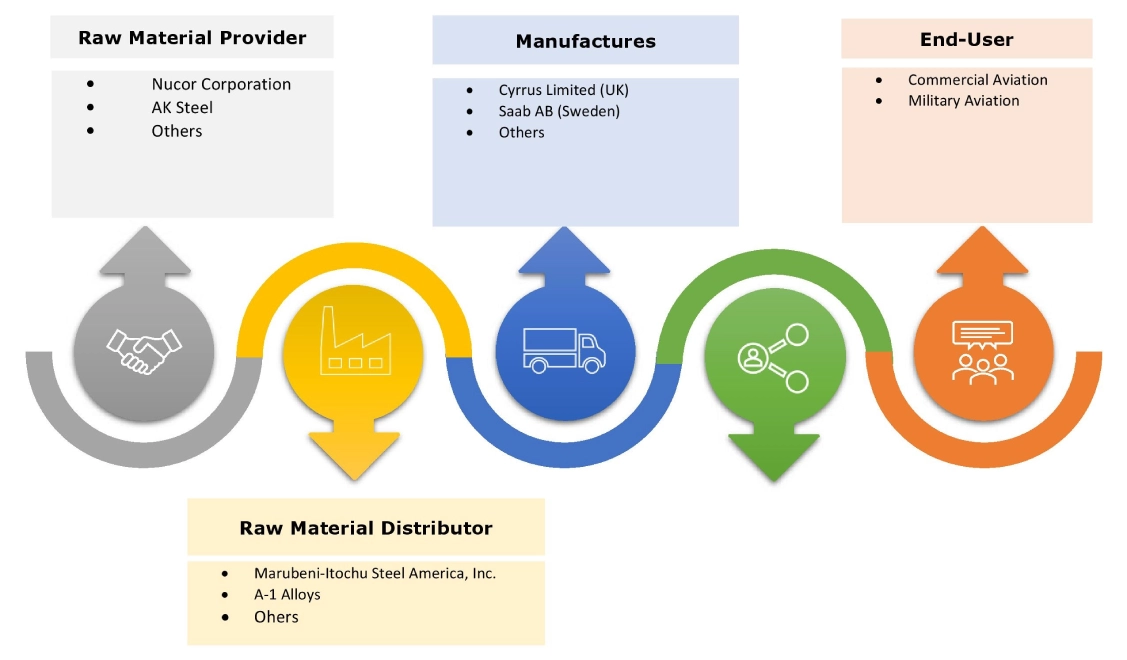- Summary
- Table Of Content
- Methodology
Air Traffic Control Equipment Market Size:
Air Traffic Control Equipment Market size is estimated to reach over USD 13,219.11 Million by 2032 from a value of USD 9,494.77 Million in 2024 and is projected to grow by USD 9,757.78 Million in 2025, growing at a CAGR of 4.5% from 2025 to 2032.
Air Traffic Control Equipment Market Scope & Overview:
Air traffic control equipment includes radar systems, flight data displays, communication networks, automated surveillance-broadcast (ADS-B) systems, meteorological sensors, and others, which are used for air traffic management. Further, it provides various benefits including enhanced safety, increased efficiency, real time communication between pilots and controllers, improved navigation, managed airspace congestion, and others. Additionally, air traffic control equipment is used in detecting and tracking aircraft in the sky, which allows communication between air traffic controllers and pilots for navigation.
Key Drivers:
Rising demand for advanced traffic management solutions due to increasing air traffic is driving the air traffic control equipment market growth
There is an increase in air traffic globally, due to growing demand of air travel in tourism sector. Further, the growing air travel is attributed to various factors including increase in business travel, the expansion of low cost carriers, and the rising trade through air cargo services. Additionally, the rise in air traffic drives the adoption of enhanced air traffic control systems for ensuring efficient airspace management, minimizing delays, and maintaining safety standards. Moreover, the deployment of modern navigation, communication, and surveillance technologies enables the swift management of air traffic at airports.
- For instance, according to the International Air Transport Association (IATA), the total air traffic witnessed an increase of 36.9% in 2023 in comparison to 2022. This is further increasing the adoption of air traffic control system at airports.
Thus, the rising air traffic is increasing the demand for efficient air traffic management solutions, in turn driving the air traffic control equipment market size.
Key Restraints:
Factors including high initial cost, maintenance cost, and others are restraining the air traffic control equipment market growth
The primary restraining factors associated with air traffic control equipment includes high initial investment, significant maintenance costs, and other operational expenses. Moreover, integrating expensive technologies such as radar systems, navigation systems, surveillance systems, and communication equipment requires a significant amount of initial investment.
Additionally, airport traffic control systems require regular maintenance, which results in significant additional maintenance and operational costs. Thus, the above factors are further restraining the air traffic control equipment market expansion.
Future Opportunities :
Rising advancements in air traffic control system including radar systems, navigation systems, and others are expected to drive the air traffic control equipment market opportunities
There is an increasing advancements in air traffic control equipment such as radar systems, navigations systems, flight data displays, communication networks, and others for enhancing air traffic control systems at airport. Further, advanced equipment enables more efficient airspace management, improved accuracy in aircraft tracking, and seamless navigation, enhancing overall operational efficiency and safety. Additionally, the integration of advanced communication systems enable real time support for the increasing demands of air traffic at airport.
- For instance, in November 2024, Leonardo collaborated with the Ministry of Transportation and Telecommunications of the Kingdom of Bahrain for enhancement and upgradation of radar systems and air traffic control at Manama Airport.
Thus, as per the air traffic control equipment market analysis, rising advancements associated with air traffic control systems for enhanced management of air space are driving the global air traffic control equipment market opportunities.
Air Traffic Control Equipment Market Segmental Analysis :
By Equipment:
Based on the equipment, the market is segmented into radar systems, flight data displays, communication networks, automated surveillance-broadcast (ADS-B) systems, meteorological sensors, and others.
Trends in the Equipment:
- There is an increasing trend towards utilization of flight data displays for sharing flight data to the passengers or important real time information.
- Increasing utilization of communication networks for efficient management of aerial and ground control.
Radar systems segment accounted for the largest revenue in the total air traffic control equipment market in 2024.
- Radar systems in air traffic control equipment are used to monitor and manage aircraft movement by detecting and tracking their location, speed, and altitude through radio waves.
- Moreover, radar system consists of transponders which are integrated in aircraft, and SSRs (secondary surveillance radars), installed at air traffic control facilities.
- Further, radar system helps in navigating aircraft through its ability to detect aircraft for ensuring safe and precise route.
- For instance, in December 2024, Thales partnered with LVNL (Luchtverkeersleiding Nederland) for delivering the RSM NG digital secondary surveillance radar with improved reliability and performance.
- Thus, the rising investments and collaborations for integrating modern radar systems are driving the air traffic control equipment market trends.
Automated surveillance-broadcast (ADS-B) systems is anticipated to register a significant CAGR growth during the forecast period.
- Automatic dependent surveillance–broadcast (ADS–B) is an advanced air traffic surveillance technology that enables aircraft to broadcast their position, velocity, and altitude in real time by using satellite navigation and on-board avionics.
- Further, ADS–B enhances airspace safety by providing accurate and continuous aircraft tracking, reducing reliance on traditional radar systems, and enabling improved situational awareness for both pilots and sir traffic controllers.
- Additionally, ADS-B is widely used in air traffic management, collision avoidance, and efficient route planning.
- For instance, L3Harris collaborated with Federal Aviation Administration (FAA), with the aim of building, designing, and operating automated surveillance-broadcast (ADS-B).
- Thus, the rising advancements related to automated surveillance broadcast systems are driving the air traffic control equipment market trends.
By Application:
Based on the application, the market is segmented into navigation, surveillance, and others.
Trends in the Application:
- There is an increasing trend towards utilization of air traffic control system to navigate flights during take-off and landing.
- Rising adoption of ATC systems for providing surveillance in military operations for providing safety and operational efficiency.
Navigation segment accounted for the largest revenue share of 42.11% in the total air traffic control equipment market share in 2024.
- Air traffic control system supports navigation by providing tools for monitoring, directing, and managing aircraft movement in airspace and on runways.
- Further, it ensures safe and efficient aircraft operations, reduces risks of collisions, improves route optimization, and enhances communication between pilots and controllers.
- ATC navigation equipment is widely used for managing flights, take-offs, landings, and ensuring safety in crowded airspaces and airports.
- For instance, in December 2022, Thales collaborated with DSNA for air traffic management with 4-FLIGHT system. Further, 4-FLIGHT is connected to ten air navigation service providers including Skyguide (CH), DFS (DE), ENAV (IT), and others.
- Thus, the rising adoption of navigation systems in airports for efficiently managing flights, take-offs, landings, and others are driving the air traffic control equipment market size.
Surveillance segment is anticipated to register a substantial CAGR during the forecast period.
- Air traffic surveillance equipment is designed to monitor and track aircraft movement within controlled airspace, ensuring operational safety and efficiency.
- In airport, surveillance systems are crucial as they detect aircraft and send detailed information to the air traffic control system for controlling air traffic.
- Further, surveillance helps in providing situational awareness, prevents mid-air collisions, improves traffic flow, and provides real time data for managing air traffic.
- Additionally, surveillance is provided by radar systems, ADS-B (Automatic Dependent Surveillance-Broadcast), and surveillance radars for tracking aircraft positions.
- For instance, in July 2024, Indra signed a contract to equip 450 airports in United States with surveillance system for improving runaway safety of surface aircrafts.
- Thus, the rising adoption of traffic control systems for surveillance application are driving the air traffic control equipment market trend.
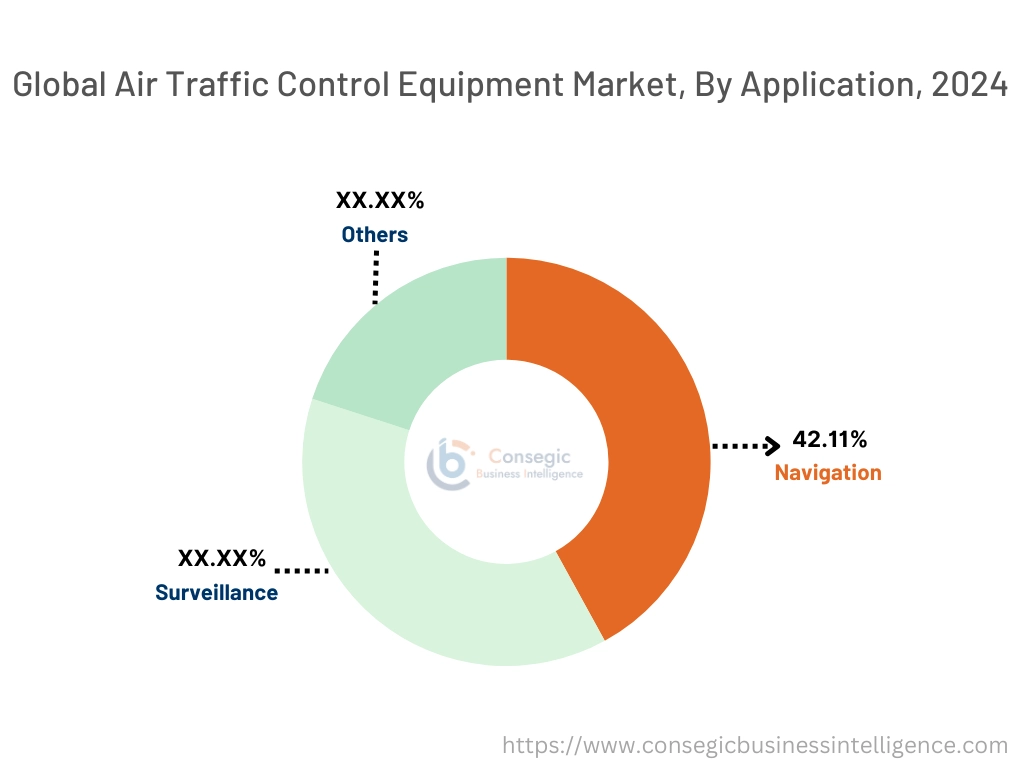
By End-User:
Based on the end-user, the market is segmented into military and commercial.
Trends in the End-User:
- Rising utilization of air traffic control system in commercial airports for enabling more productivity and flexibility for fast and quick travelling.
- Increasing adoption of ATC systems in military airports for conducting swift military operations in air.
Commercial segment accounted for the largest revenue share in the total air traffic control equipment market share in 2024.
- Air traffic control system is primarily used in commercial airports to ensure safe and efficient management of air traffic during take-off, landing, and other operations.
- Further, it enhances flight safety, minimizes delays, and optimizes airspace utilization through precise navigation, surveillance, and communication systems.
- Additionally, the use of air traffic control system in commercial airports manages aircraft movements, monitors air traffic, provides navigation assistance, and ensures secure communication between pilots and traffic control towers.
- For instance, according to Government of India, the total number of operational airports in India increased from 74 airports in 2014 to 157 airports in 2024.
- Thus, as per the analysis, the rising utilization of air traffic control system in commercial airports are driving the air traffic control equipment market.
Military segment is anticipated to register a substantial CAGR growth during the forecast period.
- In military sector, air traffic control system is used for monitoring and managing aircraft operations in military airfields, ensuring operational efficiency and safety during defense missions.
- Further, it enhances situational awareness, supports mission critical operations, ensures secure communication, and improves coordination for military aircraft.
- Moreover, military air traffic control system offers aircraft navigation, airspace management, surveillance for defense operations and enables secure and private communication.
- For instance, according to Department of Defense (DOD), the U.S. government allocated USD 1.9 trillion among 6 sub components including air force in 2024.
- Thus, as per the analysis, the rising investments in military aviation sector are driving the air traffic control equipment market.
Regional Analysis:
The regions covered are North America, Europe, Asia Pacific, the Middle East and Africa, and Latin America.
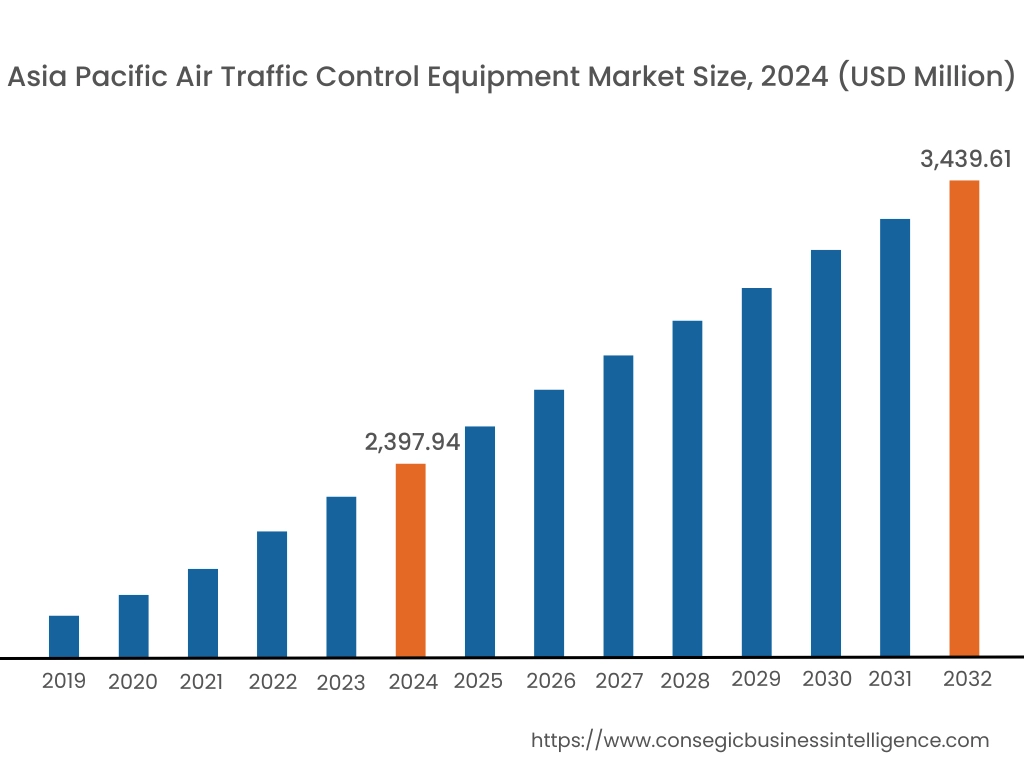
Asia Pacific region was valued at USD 2,397.94 Million in 2024. Moreover, it is projected to grow by USD 2,470.58 Million in 2025 and reach over USD 3,439.61 Million by 2032. Out of this, China accounted for the maximum revenue share of 33.4%. As per the air traffic control equipment market analysis, there is an increasing adoption of air traffic control equipment, particularly in countries such as China, India, and Japan, due to rise in construction of commercial airports for swift and smooth air transportation. The rapid development and growing investments in aviation industry are accelerating the air traffic control equipment market expansion.
- For instance, in October 2024, the Government of India allocated USD 72 billion in its budget for defense sector. This is further driving the advancement in military airport infrastructure for conducting swift missions, which is projected to drive the market in the Asia-Pacific region.
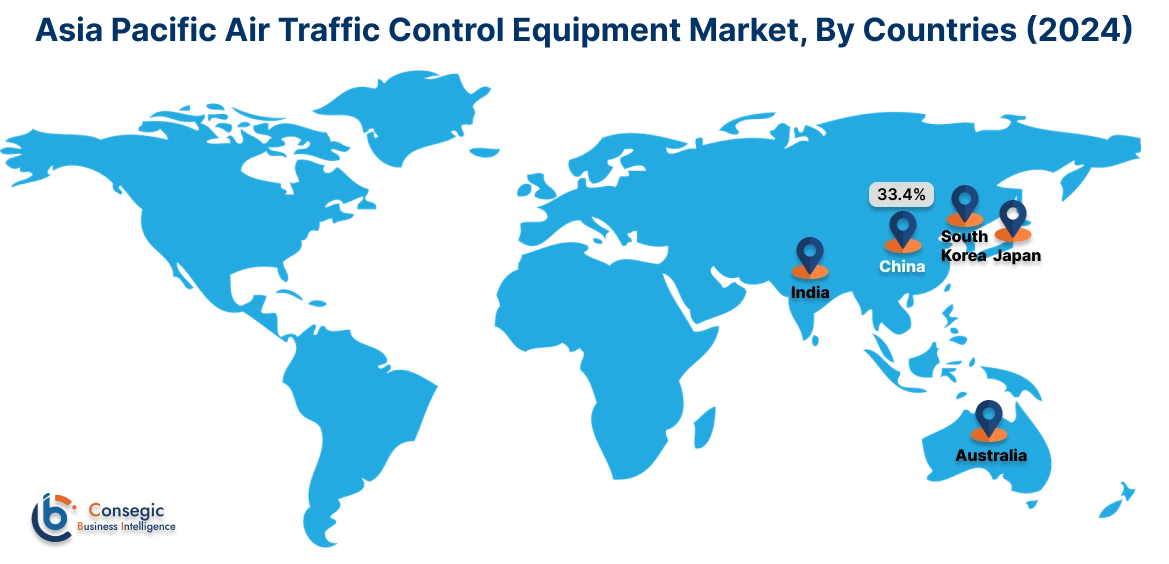
North America is estimated to reach over USD 4,667.67 Million by 2032 from a value of USD 3,353.40 Million in 2024 and is projected to grow by USD 3,446.22 Million in 2025. In North America, the growth of air traffic control equipment industry is driven by the rising investment in air defense sector. Rising adoption of helicopters, fighter jets, aircraft for military operations are also driving the market growth. Further, the increasing investment in developing advanced military airport is driving the adoption of traffic control management systems, which is contributing to the growth of air traffic control equipment market demand.
- For instance, according to the Department of Defense, the U.S. Government allocated USD 132.8 Billion for air force department in its defense sector. This is further expected to drive the adoption of air traffic control systems, which in turn is expected to drive the market in the North America during the forecast period.
The regional analysis depicts that the rising air traffic due to leisure and business travel is further driving the adoption of advanced solutions for traffic control, in turn driving the air traffic control equipment market demand in Europe. Further, as per the market analysis, the primary factors driving the market growth in the Middle East and African region includes increasing investment in aviation industry and development of air infrastructure. The rising international trade through airway is further driving the market demand in the Latin America region.
Top Key Players and Market Share Insights:
The air traffic control equipment market is highly competitive with major players providing products to the national and international markets. Key players are adopting several strategies in research and development (R&D), product innovation, and end-user launches to hold a strong position in the global air traffic control equipment market. Key players in the air traffic control equipment industry include -
- Honeywell International Inc. (US)
- Thales Group (France)
- Raytheon Technologies (US)
- Harris Corporation (US)
- BAE Systems (US)
- Cyrrus Limited (UK)
- Saab AB (Sweden)
- Indra Sistemas (Spain)
Recent Industry Developments :
Product Launch:
- In March 2024, Thales launched TopSky, an upgraded air traffic control system with safety features and seamless operations for growing air traffic.
Partnerships & Collaborations:
- In November 2024, Saab partnered with ST Engineering and Thales for providing modernization and support to Singapore’s Air Traffic Management (ATM) infrastructure.
Mergers & Acquisition:
- In November 2024, Indra acquired Global ATS and Micro Nav from the Quadrant group, with the aim of developing the ATC simulator and training solutions for its customers.
Air Traffic Control Equipment Market Report Insights :
| Report Attributes | Report Details |
| Study Timeline | 2019-2032 |
| Market Size in 2032 | USD 13,219.11 Million |
| CAGR (2025-2032) | 4.5% |
| By Equipment |
|
| By Application |
|
| By End-user |
|
| By Region |
|
| Key Players |
|
| North America | U.S. Canada Mexico |
| Europe | U.K. Germany France Spain Italy Russia Benelux Rest of Europe |
| APAC | China South Korea Japan India Australia ASEAN Rest of Asia-Pacific |
| Middle East and Africa | GCC Turkey South Africa Rest of MEA |
| LATAM | Brazil Argentina Chile Rest of LATAM |
| Report Coverage |
|
Key Questions Answered in the Report
How big is the air traffic control equipment market? +
The air traffic control equipment market was valued at USD 9,494.77 Million in 2024 and is projected to grow to USD 13,219.11 Million by 2032.
Which is the fastest-growing region in the air traffic control equipment market? +
Asia-Pacific is the region experiencing the most rapid growth in the air traffic control equipment market.
What specific segmentation details are covered in the air traffic control equipment report? +
The air traffic control equipment report includes specific segmentation details for equipment, application, end-user, and region.
Who are the major players in the air traffic control equipment market? +
The key participants in the air traffic control equipment market are Honeywell International Inc. (US), Thales Group (France), BAE Systems (US), Cyrrus Limited (UK), Saab AB (Sweden), Indra Sistemas (Spain), Raytheon Technologies (US), Harris Corporation (US), Northrop Grumman Corporation (US), and SITA (Switzerland).
